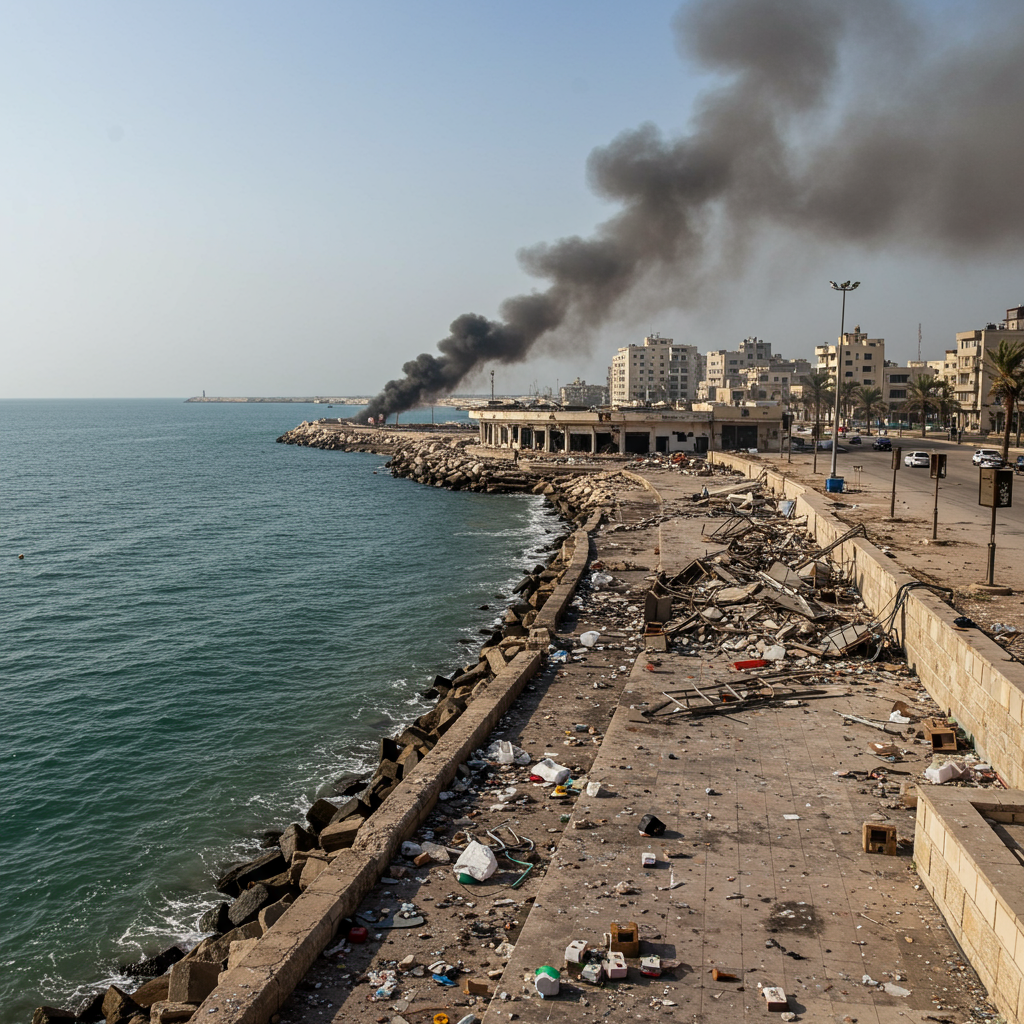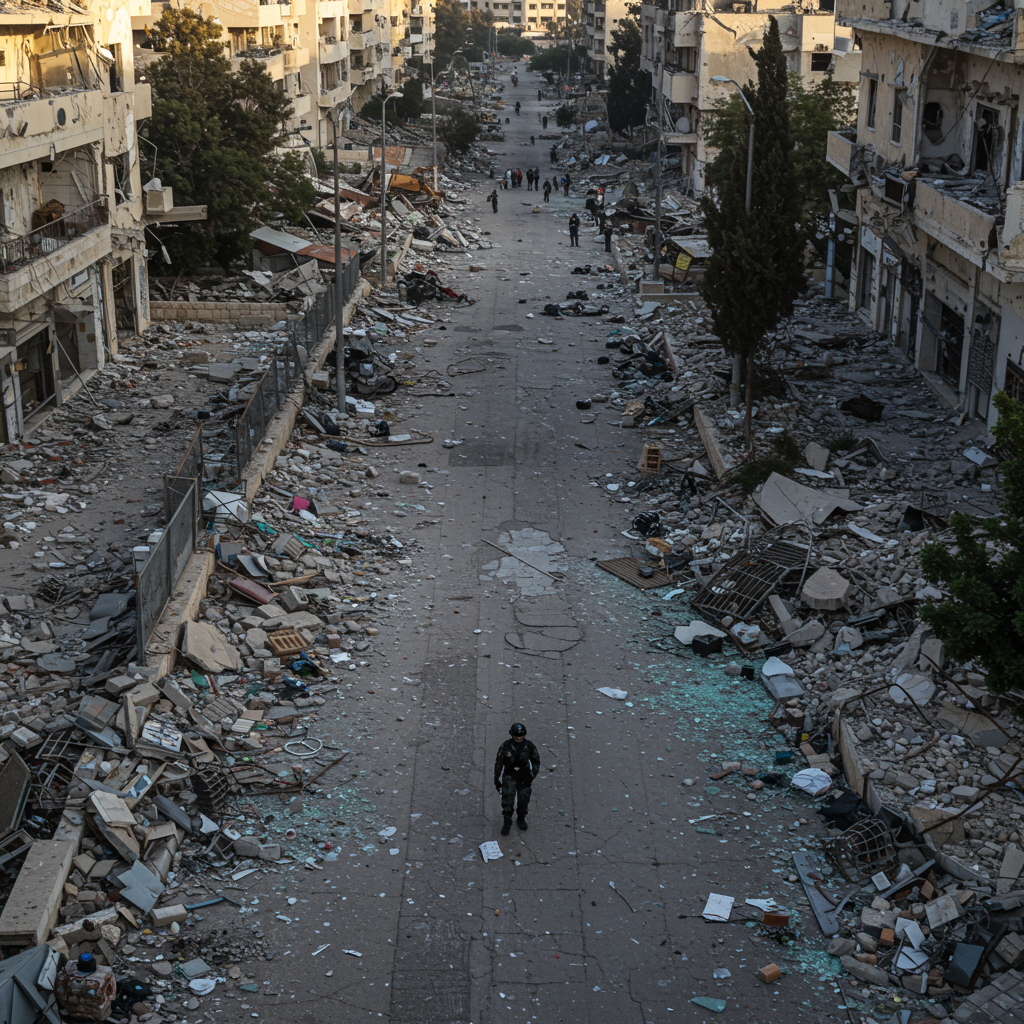An Israeli airstrike on a crowded seafront cafe in Gaza City has resulted in dozens killed and injured, transforming a scene of daily life into a horrific tragedy. The al-Baqa cafe, a popular and long-standing gathering spot on the waterfront, was reportedly hit around 3 pm on a Tuesday afternoon. Witnesses described a massive explosion that ripped through the area, immediately followed by flames, thick smoke, and widespread destruction. This devastating incident occurred amidst an escalating offensive by Israeli forces in northern Gaza.
A Coastal Respite Turned Scene of Carnage
For nearly four decades, the family-run al-Baqa cafe had served as a vital community hub in Gaza City. Situated on the shore, it offered residents a rare opportunity to escape the severe pressures of life in the densely populated territory. Under its slatted wooden roof, people gathered at plastic tables and chairs. They sought conversation, quiet moments, and a sense of normalcy away from the conflict‘s relentless toll. The cafe provided a view of the calm Mediterranean on one side. The other side showed battered buildings, wrecked hotels, and makeshift camps for displaced families. It was a place many remembered from more peaceful times. Here, friends could talk freely, share laughter, and hold onto dreams.
The cafe was busy that afternoon. Patrons included artist Amna al-Salmi and photographer Ismail Abu Hatab. Another journalist was present. Families also sought refuge, including a mother with her young children. Among them was a four-year-old child. It was a seemingly ordinary moment before the attack.
The Moment of Impact and Immediate Aftermath
Witnesses recounted the abrupt shift from peace to terror. Around 3 pm, a thunderous roaring explosion shattered the afternoon quiet. Flames erupted. A plume of ash-grey smoke shot rapidly into the sky. There was no doubt about what had happened. An airstrike had struck the cafe.
People nearby described the immediate chaos. Shrapnel flew in all directions. The air filled with smoke and the acrid smell of cordite. Visibility dropped sharply.
One witness, Abu al-Nour, 60, was just outside the cafe when the missile hit. “I stepped outside briefly to get something to eat,” he explained. “When I returned – just as I was close – a missile struck.” He ran towards the cafe. He found it completely destroyed. Bodies lay on the ground within the wreckage. He reported that all the cafe workers were killed.
Adam, 21, worked nearby, renting chairs on the promenade. He rushed to the site. “When I reached the site, the scenes were beyond anything imaginable,” Adam told The Guardian. He knew the cafe workers well. He noted it was full of customers of all ages. Another witness, Ahmad al-Nayrab, 26, called it a “massacre.” He described seeing body parts and mangled, burned bodies amidst screams.
Witness Accounts Detail Horrific Injuries
Surviving witnesses shared grim details of the casualties. Some saw a dead child among the victims. Others described an elderly man who had suffered the severing of both legs. Many others sustained serious injuries.
The extent of the damage surprised those who saw it. The entire cafe was wrecked. Concrete columns were warped. Debris was scattered everywhere. Amidst the destruction, a deck of cards and a large stuffed toy animal were visible. Even hours later, one witness reported, the air still “smelled of blood.”
Many expressed shock that the cafe could be targeted. A 55-year-old sports teacher living nearby called the cafe the “nicest in Gaza.” He believed it “should have been the safest of anywhere” in the territory.
Escalating Conflict and Military Response
The attack on the al-Baqa cafe occurred during a period of intensified Israeli military activity in Gaza. In recent days, the Israel Defense Forces (IDF) had reportedly escalated its offensive across the territory. A particular focus was placed on northern Gaza. This is an area where Hamas militants reportedly remain entrenched.
IDF statements indicated operations involved both ground forces and airstrikes. Tanks had advanced into neighborhoods east of Gaza City. New “evacuation orders” had forced thousands from makeshift shelters. Airstrikes had killed dozens across the northern areas.
An IDF spokesperson addressed the cafe incident. They stated the attack was under review. The spokesperson added that the Israeli military had “struck several Hamas terrorists in the northern Gaza Strip.” They also claimed that “prior to the strike, steps were taken to mitigate the risk of harming civilians using aerial surveillance.”
A separate IDF statement on Tuesday provided context. It reported that Israel’s air force had attacked more than 140 “terror targets” in Gaza over the previous day. These targets included “terrorists, anti-tank missile launch posts, weapons storage facilities and other terrorist infrastructure.”
The Human Toll: Casualties and Loss
Medical officials and other sources provided casualty figures for the cafe strike. Estimates ranged from 24 to 36 Palestinians killed. Dozens more suffered injuries.
The victims represented diverse segments of Gaza’s population. Artist Amna al-Salmi was killed. She was known for initiatives promoting Palestinian art internationally. She also supported displaced communities. Photographer and film-maker Ismail Abu Hatab also died. Abu Hatab had been injured earlier in the conflict. He had previously spoken about how his work documenting the war “haunted” him.
Among the fatalities was Nour al-Huda al-Husari, 35. She had gone to the cafe with her two daughters seeking fresh air. Her husband, Mohammed al-Husari, desperately tried to reach her after hearing about the strike. His calls went unanswered. About 90 minutes later, he learned she had been killed. His immediate concern was for his daughters.
One daughter, aged eight, was miraculously found standing stunned but unharmed meters away from the blast site. However, her older sister, aged 12, sustained severe injuries. She suffered a skull fracture and internal bleeding. Her condition was critical.
Mohammed al-Husari described the scene at the hospital. It was overwhelmed with the wounded and dead. He emphasized that the cafe was a civilian spot. “It was not a suspicious or military place,” he stated. His wife was always cautious to avoid risky locations. “The truth is there is no safe place in Gaza,” he concluded somberly.
Humanitarian Crisis Deepens Amidst Conflict
The attack highlights the severe humanitarian conditions across Gaza. Beyond casualties from strikes, hundreds have reportedly died seeking aid in recent weeks. While a small number can afford basic necessities and access services like Wi-Fi at venues like cafes, the vast majority face extreme hardship. Gaza’s population of 2.3 million suffers acutely. Widespread malnutrition is reported. The threat of famine continues to grow.
Aid distribution efforts face significant challenges. Accessing aid has become chaotic and dangerous. Reports cite incidents of violence against Palestinians attempting to reach aid sites. Gaza’s health ministry reported hundreds killed around distribution points in the past month alone. Charities argue civilians face a terrible choice: starve or risk death trying to get food.
The Israeli military has acknowledged harm to civilians seeking food. They stated instructions were issued after “lessons learned.” Aid delivery remains far below the required levels. Roads are damaged. Military restrictions persist. Ongoing strikes and looting further complicate efforts.
This incident occurs within the broader context of the 20-month war. The conflict began after a Hamas attack on Israel in October 2023. That attack killed about 1,200, mostly civilians. Around 250 were abducted. The ensuing Israeli offensive has reportedly killed over 56,500 Palestinians. Local health authorities attribute most deaths to civilians. Much of the territory has been reduced to ruins.
Ceasefire negotiations remain complex. Despite diplomatic efforts and reports of potential deals, incompatible demands persist. Hamas seeks a permanent end to the war and refuses to disarm. Israel insists on defeating Hamas and will not withdraw entirely. This stalemate contributes to the ongoing violence and humanitarian catastrophe affecting civilians daily.
Frequently Asked Questions
What happened at the Al-Baqa cafe in Gaza City?
The Al-Baqa cafe, a popular seafront spot in Gaza City, was struck by an Israeli airstrike on a Tuesday afternoon. The attack resulted in dozens of fatalities and injuries. Witnesses described a large explosion, flames, and extensive destruction at the cafe, which was crowded with civilians seeking respite from the conflict. The incident transformed the previously peaceful location into a scene of carnage, with victims including families, artists, and journalists.
What is the humanitarian situation like in Gaza following recent events?
Gaza faces a severe humanitarian crisis, exacerbated by the ongoing conflict and recent events like the cafe strike. Malnutrition is widespread, and the threat of famine looms for the majority of the 2.3 million population. Accessing essential aid, including food and water, is extremely difficult and dangerous, with reports of hundreds killed while trying to reach distribution points. Basic necessities are scarce, and aid delivery is significantly insufficient to meet the population’s needs amidst widespread destruction and restricted access.
How does this event relate to ongoing ceasefire efforts?
The deadly airstrike on the Al-Baqa cafe occurred while diplomatic efforts and discussions about a potential ceasefire were reportedly underway. The intensification of military operations, including strikes like the one on the cafe, sometimes coincides with phases of negotiation in the conflict. While there are reports of attempts to reach an agreement to end the war and secure the release of hostages, a deal remains elusive due to fundamental disagreements between the involved parties, highlighting the continued violence civilians face even amidst talks.
Conclusion
The Israeli airstrike on the al-Baqa cafe stands as a stark reminder of the devastating impact of the ongoing conflict on civilians in Gaza. What was once a place of peace and community became a site of mass casualties and destruction. Witness accounts paint a harrowing picture of the immediate aftermath and the immense human suffering. This tragedy underscores the profound risks faced by Palestinians daily, highlighting the urgent need for safe zones, effective aid delivery, and ultimately, a resolution to the protracted conflict that has brought immense hardship and loss to the territory. The incident adds another layer to the complex humanitarian crisis unfolding, emphasizing the desperate search for safety and basic necessities in a place where many feel there is no truly safe refuge.



